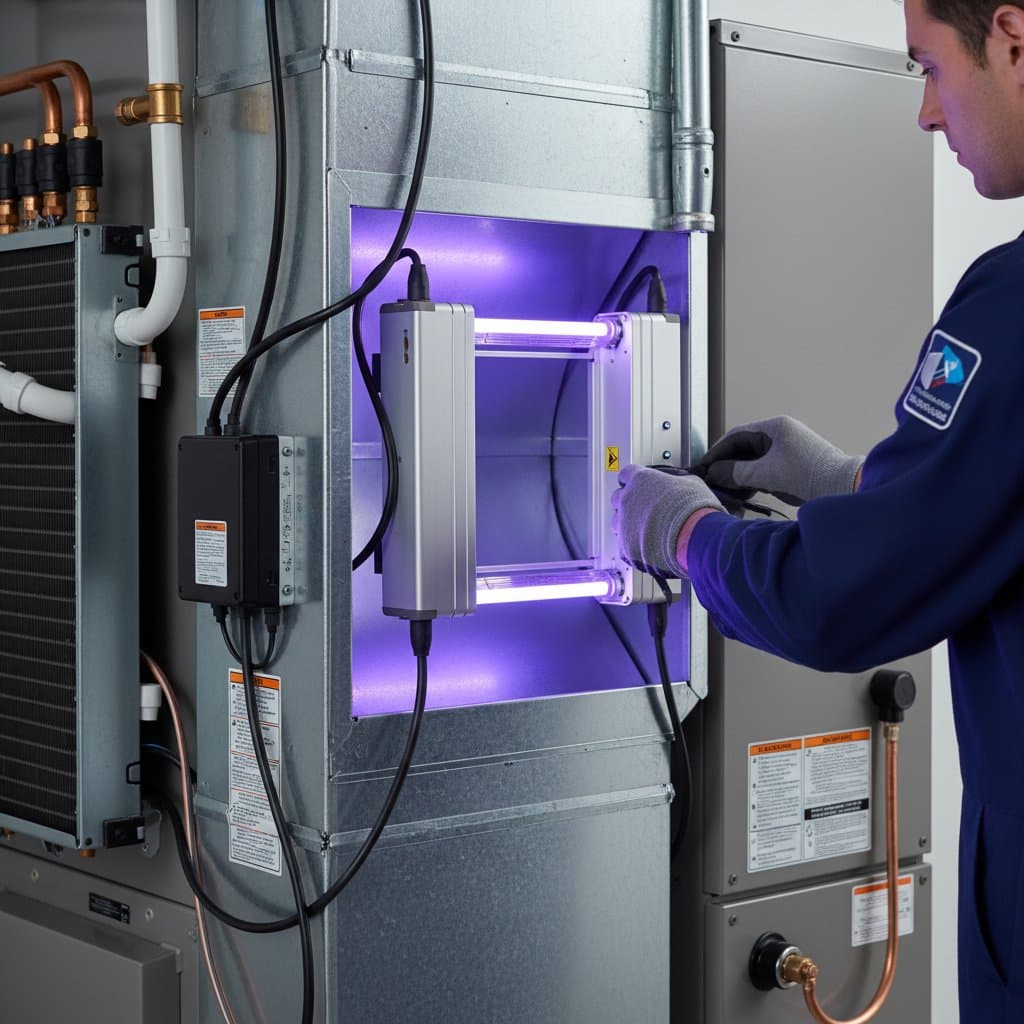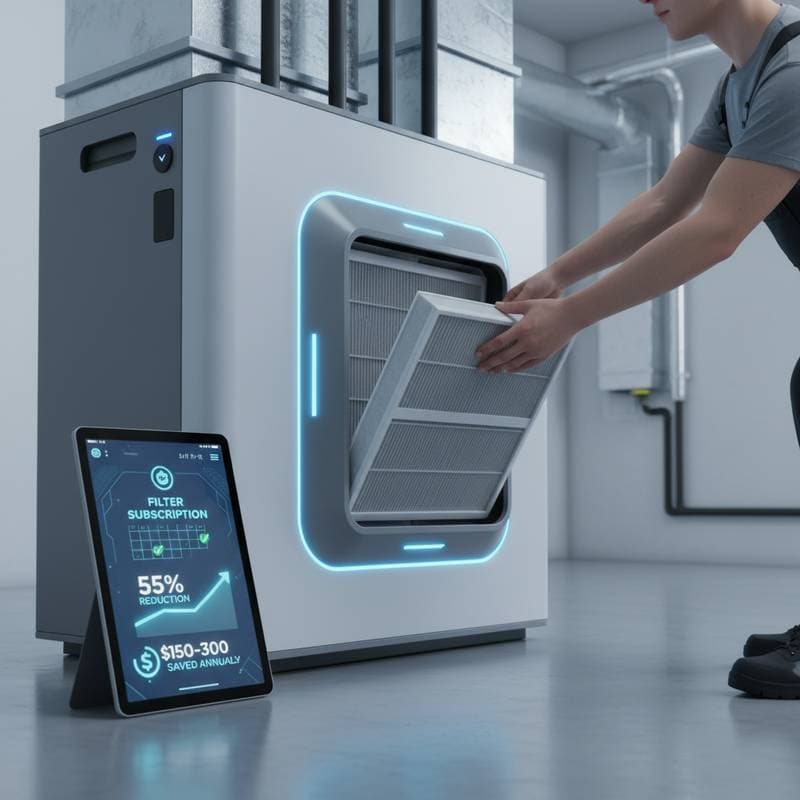Why HVAC Professionals Standardize UV-C Air Purifiers
Homeowners prioritize indoor air quality more than ever, prompting HVAC professionals to incorporate UV-C air purifiers as a core component in contemporary systems. These devices address airborne bacteria, mold spores, and viruses effectively. Integration occurs in both residential and commercial HVAC configurations to foster healthier indoor spaces.
This guide details the rationale behind this standardization, the operational principles of UV-C systems, associated costs, and key advantages for indoor environments. It covers installation considerations, ongoing maintenance, and guidance for homeowners evaluating upgrades.
Average Costs of UV-C Air Purifiers for HVAC Systems
Costs fluctuate according to unit type, manufacturer, and installation demands. The following table outlines typical expenses, encompassing materials and labor.
| Type | Average Cost | Details |
|---|---|---|
| Coil-mounted UV-C light | $450 – $750 | Focuses on microbial inhibition directly on the evaporator coil. |
| In-duct dual UV-C system | $700 – $1,200 | Processes air throughout the duct network for comprehensive home coverage. |
| Portable UV-C air purifier | $150 – $400 | Suited for individual rooms, though not connected to central HVAC. |
| Commercial-grade UV-C array | $1,200 – $3,000 | Designed for expansive facilities or robust HVAC infrastructures. |
In-duct UV-C systems remain the preferred choice for homeowners seeking thorough air treatment. Such investments yield returns via diminished maintenance demands, elevated air purity, and heightened HVAC performance.
Key Factors Influencing UV-C Installation Costs
Multiple elements determine the overall expense of UV-C air purification setups.
Equipment Type and Wattage
Lamps with greater wattage manage broader areas and deactivate more pollutants, yet they demand higher initial outlays. Smaller configurations suit modest residences and prove more economical.
System Scale and Duct Configuration
Elaborate duct arrangements or sizable HVAC units often necessitate several UV-C lamps for adequate coverage. This elevates both material and labor expenditures.
Labor and Access Challenges
Regional labor rates and ease of access to the system impact pricing. Positions in confined or remote duct sections extend installation duration and costs.
Bulb Replacements and Upkeep
UV-C bulbs endure 9 to 12 months of service before needing substitution. Replacement prices span $50 to $150 per bulb, varying by specification. Consistent upkeep sustains optimal functionality.
Supplementary Air Quality Enhancements
Certain homeowners combine UV-C with HEPA filters, activated carbon elements, or ionization devices. These pairings provide sophisticated filtration yet increment the total investment.
Maintenance and Durability of UV-C Purifiers
Essential Maintenance Practices
Upkeep proves simple for UV-C systems. Homeowners or certified technicians must:
- Swap bulbs yearly or per manufacturer guidelines.
- Wipe down lamp enclosures and adjacent areas during routine checks.
- Verify secure electrical links and operational status of lights.
Projected Service Life
Well-maintained UV-C systems endure 8 to 10 years. Bulbs represent the main replaceable parts.
Frequently Asked Questions About UV-C Air Purifiers
How Effective Are UV-C Air Purifiers Against Viruses and Bacteria?
UV-C illumination excels at deactivating numerous airborne microbes when installed and maintained correctly. It functions optimally within a multi-tiered strategy incorporating filtration and ventilation. Although it does not eradicate all particulates, it markedly diminishes microbial presence in circulating air.
Do UV-C Lamps Generate Ozone?
Contemporary UV-C lamps operate without ozone production. Homeowners must verify that selected models qualify as ozone-free, particularly for interior applications.
Optimal Placement for UV-C Lights in HVAC Systems
Professionals position UV-C lamps adjacent to the evaporator coil or within the return air plenum. Location hinges on air circulation patterns and system architecture. Correct positioning maximizes contact while safeguarding components.
Frequency of Bulb Replacements
Annual replacement stands as the norm. Germicidal potency wanes over time, even if illumination persists. Timely swaps preserve efficacy.
Safety of UV-C Purification for Building Occupants
Proper enclosure within the HVAC confines UV-C light, shielding occupants from exposure. Technicians advise avoiding direct contact during servicing.
Retrofitting UV-C Systems to Existing HVAC Units
Most configurations accommodate UV-C additions. Experts assess ductwork and propose tailored setups for effective distribution.
Do UV-C Systems Substitute for Air Filters?
UV-C complements filtration without replacing it. Filters trap debris and particulates, whereas UV-C targets submicron biological threats.
Securing Quotes for UV-C Air Purifier Installations
Quote Process Overview
Technicians evaluate the HVAC setup, gauge duct sizes, and identify ideal lamp sites during quoting. Estimates encompass hardware, workmanship, and upkeep advice.
Essential Questions for Contractors
- Does the UV-C unit align with my current HVAC setup?
- What lamp wattage suits my residence?
- What is the maintenance and replacement schedule?
- Are the lamps certified ozone-free?
- What warranties apply to the equipment and work?
- Will installation alter efficiency or air movement?
- Can you furnish a detailed cost breakdown?
- What is the projected installation timeline?
- Do you provide service agreements for UV-C maintenance?
- What additional air quality options merit consideration?
Sustaining Long-Term Benefits from UV-C Systems
Post-installation, UV-C purifiers demand minimal intervention while providing enduring gains. Periodic reviews by qualified HVAC specialists confirm lamp performance and system cleanliness. Adopters frequently report reduced odors, pristine ducts, and reliable air circulation.
HVAC standardization of UV-C technology advances expectations for indoor air purity. This integration of UV-C with advanced HVAC engineering offers a reliable, evidence-based path to superior air quality. Homeowners embracing this upgrade safeguard their systems and cultivate enduring comfort and sanitation.





